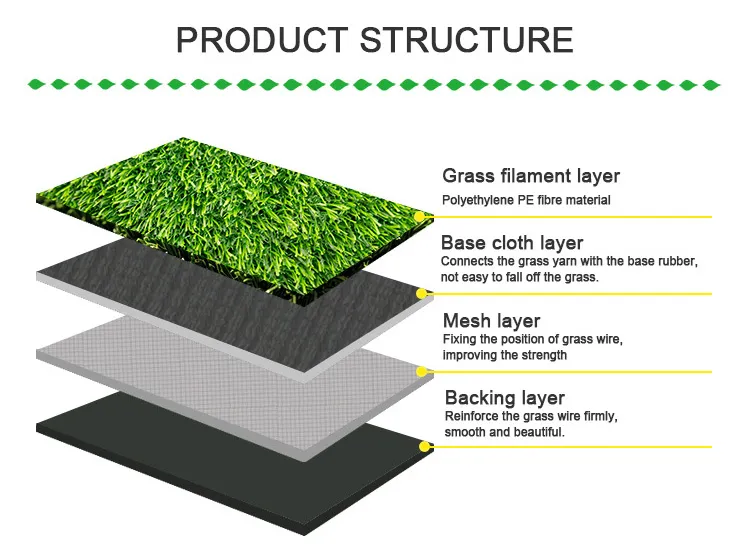
- Afrikaans
- Arabic
- Belarusian
- Bengali
- Czech
- Danish
- Dutch
- English
- Esperanto
- Estonian
- Finnish
- French
- German
- Greek
- Hindi
- Hungarian
- Icelandic
- Indonesian
- irish
- Italian
- Japanese
- kazakh
- Rwandese
- Korean
- Kyrgyz
- Lao
- Latin
- Latvian
- Malay
- Mongolian
- Myanmar
- Norwegian
- Persian
- Polish
- Portuguese
- Romanian
- Russian
- Serbian
- Spanish
- Swedish
- Tagalog
- Tajik
- Thai
- Turkish
- Turkmen
- Ukrainian
- Urdu
- Uighur
- Uzbek
- Vietnamese
artificial grass on soil
Oct . 06, 2024 20:05 Back to list
The Uses and Benefits of Artificial Grass on Soil
Artificial grass has gained widespread popularity in recent years, transforming the landscape of sports fields, residential lawns, and commercial properties. While it often serves as a substitute for natural grass, one of the lesser-discussed aspects is its installation on soil. This article delves into the implications and benefits of using artificial grass on soil, illustrating how it can be a practical and sustainable choice.
What is Artificial Grass?
Artificial grass, often referred to as synthetic turf, is made from a combination of materials designed to imitate the look and feel of natural grass. It typically consists of polyethylene, polypropylene, or nylon fibers, which are tufted into a backing material. The result is a durable and low-maintenance surface that can withstand various weather conditions.
The Installation Process
Installing artificial grass involves several steps, starting with soil preparation. The soil must be properly treated to create a level and stable base for the synthetic turf. This may involve removing existing vegetation, grading the surface, and adding a layer of crushed stone or gravel for drainage. Once the ground is prepared, a weed barrier fabric is often placed before the artificial grass rolls are laid down, ensuring that weeds do not penetrate through the synthetic surface.
Benefits of Artificial Grass on Soil
1. Water Conservation
One of the most significant benefits of artificial grass is its ability to conserve water. Traditional lawns require continuous watering, often leading to significant water consumption, especially in arid regions. In contrast, artificial grass does not need any watering, which makes it an environmentally friendly option. By using artificial grass on soil, homeowners and businesses can reduce their water bills and contribute to water conservation efforts.
Natural grass requires regular maintenance, including mowing, fertilizing, and pest control. Installing artificial grass on soil eliminates the need for these activities. This not only saves time and labor but also reduces the use of chemicals that can harm the environment. With synthetic turf, occasional brushing and rinsing to remove debris and dust are typically all that is needed to keep the surface in good condition.
artificial grass on soil

3. Durability and Longevity
Artificial grass is designed to withstand heavy foot traffic and adverse weather conditions, making it suitable for various applications, such as sports fields, playgrounds, and pet areas. When installed on soil, the durability of artificial grass ensures that it can retain its appearance and functionality over the years, resulting in a long-term investment.
4. Aesthetic Appeal
For many, the visual appeal of a well-manicured lawn is essential. Artificial grass can provide a consistently green and lush appearance year-round, regardless of seasonal changes. This aesthetic appeal can enhance the overall look of properties, making them more inviting and attractive. The texture of synthetic turf is designed to mimic natural grass, providing a visually pleasing environment for recreational activities.
5. Environmental Benefits
While the production of artificial grass involves certain environmental considerations, the long-term benefits potentially outweigh these concerns. The reduction in water usage, decreased reliance on pesticides and fertilizers, and the elimination of lawn maintenance equipment all contribute to a smaller ecological footprint. Furthermore, many manufacturers are now producing turf from recycled materials, promoting sustainability within the industry.
6. Accessibility
Artificial grass can create accessible spaces for a variety of users, including those with mobility challenges. The even surface and lack of mud make it easier for wheelchairs and walking aids to navigate. This inclusivity can promote social interaction and recreational opportunities for people of all abilities.
Conclusion
The installation of artificial grass on soil presents numerous advantages for homeowners, businesses, and communities alike. From water conservation and low maintenance requirements to aesthetic appeal and environmental benefits, synthetic turf is becoming an increasingly attractive alternative to natural grass. As with any landscaping decision, it's essential to weigh the pros and cons based on individual needs and environmental considerations. Nonetheless, artificial grass offers a sustainable solution that is changing the way we think about lawns and recreational spaces.
-
The Benefits of Artificial Turf for Indoors
NewsJul.15,2025
-
How Artificial Grass Suppliers Ensure Quality Products
NewsJul.15,2025
-
Artificial Grass and Pets: A Space for Relaxation
NewsJul.08,2025
-
Balcony & Outdoor Decoration with Artificial Grass
NewsJul.08,2025
-
Best Indoor Artificial Grass for Home
NewsJul.07,2025
-
Best Pet Turf for Dogs: Safe & Durable Artificial Grass Options
NewsJul.07,2025
Products categories









